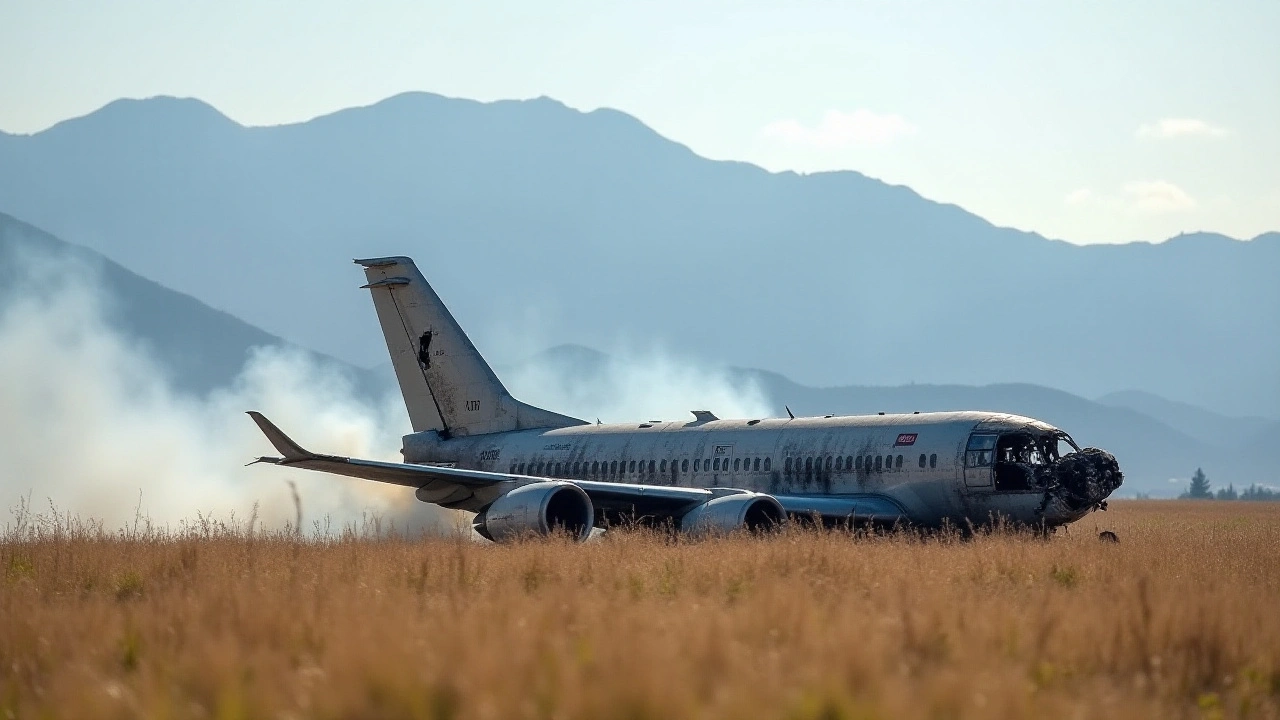Devastating Plane Crash at Muan International Airport
A calamitous event unfolded at South Korea's Muan International Airport with the crash of Jeju Air Flight 2216, a Boeing 737-800. This tragic incident has resulted in the loss of 179 lives, marking it as one of the deadliest aviation disasters in the region's recent history. Returning from a routine flight from Bangkok, the aircraft was making its final approach when catastrophe struck, leading to an immense loss that has sent shockwaves across the globe. Amidst an overcast sky, the flight attempted to land, unaware of the tragic sequence that would soon unfold.
Chronicle of the Tragedy
The ill-fated flight, packed with 175 passengers and six crew members, was in the process of descending towards its designated runway when fate intervened. Initial findings suggest a failure of the landing gear to deploy, a critical component in ensuring a safe touchdown. Without the essential support of its landing gears, the aircraft couldn't maintain stability and overran the runway boundaries. This mishap led to a collision with the airport's perimeter wall, triggering a catastrophic sequence that culminated in the plane engulfing in flames.
Amongst the wreckage, two individuals emerged, defying all odds. The survivors, identified as flight attendants positioned at the rear, miraculously escaped the raging inferno. These harrowing accounts add a poignant chapter to an already traumatic event, painting a vivid image of the horror that unfolded within moments.
Investigations and Responses
The aftermath of such a disaster calls for meticulous analysis and comprehensive investigations. The South Korean Aviation and Railway Accident Investigation Board has taken the helm of the probe. Understanding the gravity of the situation, international bodies have extended their hand, keen on preventing further tragedies. The US National Transportation Safety Board (NTSB) and Boeing have joined forces with South Korean authorities, pooling their resources and expertise to decode the events leading to this calamity.
Current investigations hinge on multiple facets, each demanding rigorous scrutiny. Mechanical failure, encompassing issues beyond the landing gear, is a primary focal point. However, human error remains a possibility, with investigators delving into the actions of the crew during the final moments. Furthermore, the airport's infrastructure and layout could have played a pivotal role, with external factors potentially influencing the disaster's course.
Political Turmoil and Aviation Safety
As the nation mourns, the political atmosphere in South Korea adds an additional layer of complexity. The crash coincides with a turbulent political backdrop, shadowed by the impeachment of President Han Duck-soo. The political vacuum created by such a high-stake event has led to martial law's imposition, a decision not without controversy. Amid this uncertainty, acting President Choi Sang-mok faces the daunting task of maintaining order while dealing with a national tragedy.
Amid these political undertones, the spotlight shifts to aviation safety, a subject of paramount importance globally. This crash, the 12th fatal occurrence involving a Boeing 737-800, raises pertinent questions regarding aircraft design and operational safety standards. For the families affected, these questions aren’t about policy—they're about loved ones lost too soon.
A Nation's Resilience
South Korea's response has been swift and coordinated, reflecting its commitment to addressing the crisis at hand. Emergency responders have been mobilized en masse, with all available resources directed towards recovery efforts. As rescue teams sift through the debris, their task is both heart-wrenching and hopeful—recovering the remains of loved ones and, perhaps, discovering further survivors.
For the people of South Korea, this tragedy serves as a somber reminder of life's fragility. Yet, within the shared sorrow and grief, there lies a determination to rebuild, remember, and eventually, heal. As the investigation continues, the findings will play a crucial role not only in providing closure to the bereaved but also in shaping future aviation safety protocols worldwide.
The Path Forward
As authorities and aviation bodies converge to uncover the truth, the world watches, hoping that lessons learned from this calamity will catalyze change. The ultimate goal is a safer future, where air travel becomes synonymous with trust and security. Until then, the global community stands with South Korea, offering support, solidarity, and a shared hope for healing and prevention in equal measure.






Surya Shrestha
December 30, 2024 AT 18:11In the wake of the Muan catastrophe, one must, with solemnity and precision, acknowledge the manifold ramifications-both aeronautical and sociopolitical-affecting the Korean Peninsula; the tragedy, undeniably, underscores a profound exigency for systemic reform, exhaustive inquiry, and unequivocal accountability.
Rahul kumar
January 9, 2025 AT 06:20hey folks, check out the latest safety protocols i found, they can actually help avoid gear failures like the one in Muan lets all airlines adopt them asap i read that modern 737s have redundant hydraulic lines, definately a good thing to look into.
mary oconnell
January 18, 2025 AT 12:33So, while the world mourns, we might as well deploy a heuristic that frames this calamity as a stark exemplification of systemic risk accumulation; after all, what's a little tragedy when the aviation ontology is already saturated with latent failure modes, right?
Michael Laffitte
January 27, 2025 AT 18:46Wow, the sheer scale of this disaster is heartbreaking-my thoughts are with every family, and I hope the collaborative spirit of the global aviation community can rise like a phoenix from these ashes.
sahil jain
February 6, 2025 AT 01:00Stay strong, everyone! This is a tough moment, but together we can push for better safety standards 😊
Bruce Moncrieff
February 15, 2025 AT 07:13Look, the data suggests a gear deployment glitch, which means engineers need to double‑check the actuation circuits and we, as watchers, must keep demanding transparency
Dee Boyd
February 24, 2025 AT 13:26From an ethical standpoint, this incident exemplifies a gross dereliction of duty; the confluence of regulatory complacency, corporate profit‑driven inertia, and deficient safety culture culminated in an avoidable loss of life.
Carol Wild
March 5, 2025 AT 19:40It is an undeniable truth that the Muan disaster, far from being an isolated mishap, serves as a chilling exemplar of the deep‑seated vulnerabilities inherent within contemporary aerospace architecture. The propensity for mechanical failure, especially within critical subsystems such as the landing gear, has been repeatedly documented in peer‑reviewed literature, yet regulatory bodies appear to have adopted a complacent stance. Moreover, the geopolitical climate of the Korean Peninsula, fraught with internal power struggles and external pressures, only exacerbates the opacity surrounding safety oversight. One cannot overlook the insidious influence of corporate profit motives, which, when coupled with a culture of cost‑cutting, generate an environment ripe for catastrophe. In parallel, the role of international aviation authorities, ostensibly guardians of global standards, has been reduced to a perfunctory rubber‑stamping exercise. The convergence of these factors-technical, political, and economic-creates a perfect storm that precipitates tragedies such as the one witnessed at Muan. It is therefore incumbent upon every stakeholder, from engineers to policymakers, to adopt a posture of relentless scrutiny. Yet, the echo of past incidents, from the Boeing 737 MAX debacles to the Air France 447 calamity, seems to have been relegated to the footnotes of history books. This selective amnesia, I contend, is symptomatic of a deeper societal inclination to prioritize convenience over safety. The survivors, though few, bear witness to the harrowing reality that safety protocols are not merely abstract regulations but matters of life and death. Their accounts should galvanize a renewed commitment to rigorous testing regimes, redundancy engineering, and transparent reporting mechanisms. Additionally, the media’s sensationalist framing of such events, while capturing public attention, often obscures the nuanced technical discourse required for substantive reform. As observers, we must demand that investigative findings be disseminated in a comprehensible yet scientifically accurate manner. Only through an informed populace can the necessary political will be mobilized to enforce stringent compliance. In conclusion, the Muan tragedy stands as a stark reminder that without systemic overhaul, the specter of similar disasters will inexorably loom over the skies.
Rahul Sharma
March 15, 2025 AT 01:53Regarding the investigative protocols, it is imperative-indeed, absolutely requisite-that South Korean authorities coordinate with the International Civil Aviation Organization, the European Union Aviation Safety Agency, and the U.S. National Transportation Safety Board; this multilateral synergy will ensure comprehensive data sharing, cross‑regional expertise integration, and a robust framework for preventive measures.
Emily Kadanec
March 23, 2025 AT 18:11i already know the root cause will be a software bug.